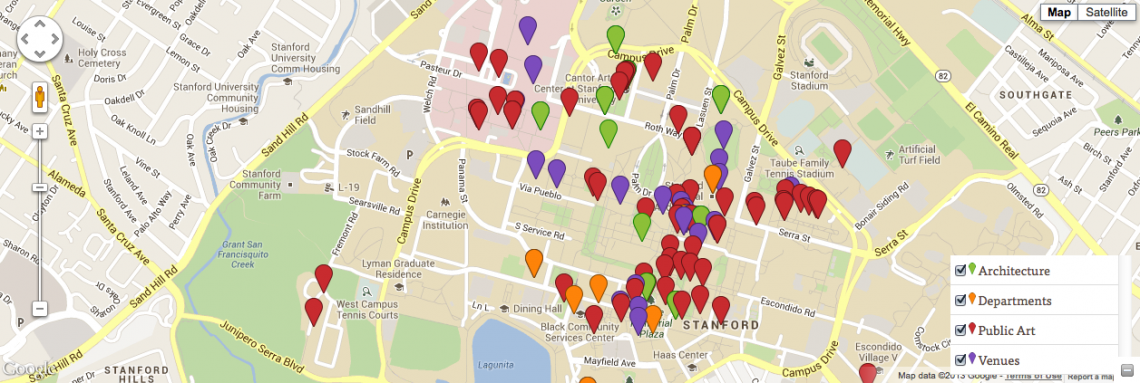
New maps showcase public art treasures on Stanford campus
Stanford has created two new maps – the interactive online Stanford Arts Map and the sturdy paper Campus Arts Map – to help art lovers find their way to one or all of the university's 87 works of public art, including murals, sculptures and installations, located outdoors and in the lobbies of new buildings.
While the Burghers of Calais is a favorite stop for visitors who pose for photos with Auguste Rodin’s larger-than-life bronze statues in Memorial Court, there are dozens of other public art treasures all over the Stanford campus awaiting visits from art lovers.
Strolling across campus, students, faculty, staff and visitors can encounter art at almost every turn – every day of the year – located outdoors and in the lobbies of buildings, including two new buildings at Stanford School of Medicine.
To showcase its public art, the university has created the Stanford Arts Map, an interactive website showing the location of 87 artworks on campus created by artists from around the world.
In addition to sculptures from the 19th, 20th and 21st centuries, the Stanford Arts Map highlights many other treasures of public art, including murals, paintings, installations, totem poles and etched black granite panels that double as benches.
Many of the pieces come from the Cantor Arts Center collection.
The map can be easily viewed on a smart phone or a tablet, making it a portable reference guide on campus walks.
“I have just been so struck by how much great art we have on our campus,” said Matthew Tiews, executive director of arts programs at Stanford. “I really want the Stanford community and our neighbors and visitors to be aware of our treasures and have an easy way to find the pieces so they can engage with them.”
Red pins on the Stanford Arts Map indicate the locations of public art on campus.
Clicking on a red pin reveals a tiny photo, the name of the artwork and its location; for example: “Tre Stelle di Lapislazzuli: Atrium of the Lorry I. Lokey Stem Cell Research Building.” By clicking on the artwork’s title, the website opens to a page devoted to the piece, with detailed information about the work and the artist who created it.
The three-tiered chandelier – Three Stars of Lapis Lazuli – hangs in the soaring atrium of the building and can be viewed indoors during the day. At night, when it is lit, passersby can admire the hand-blown glass pieces as they sparkle with gold through the building’s tall plate-glass windows.
“If someone’s attention is spontaneously grabbed by a sculpture on campus, I want them to be able to find out its history and the creative spirit behind it,” Tiews said.
The Stanford Arts Map includes information on Stanford’s latest acquisition, Three Fold, an iridescent latticework sculpture by Alyson Shotz. It was installed earlier this year in the second story lobby of the Li Ka Shing Center for Learning and Knowledge.
The map also shows the locations of exceptional architecture (green pins) on campus, from the historic Old Union to the modern William H. Neukom Building at Stanford Law School. In addition, it includes information about Stanford’s arts departments (orange), as well as programs, venues and galleries (purple) that are devoted to the arts.
For those who would like to plot an arts walking tour using a paper map, Stanford created the sturdy, compact Campus Arts Map, which identifies the locations of 32 works of public art on campus.
The Campus Arts Map is available at Cantor Arts Center and the Stanford Visitor Center.
Using the map, art lovers can plot a course to a mural (El Centro Chicano Façade Mural), a galloping horse (Horse in Motion), an undulating sandstone wall made of stone scavenged from Stanford buildings destroyed in earthquakes (Stone River), a sculpture garden (Papua New Guinea Sculpture Garden), a contemporary monument (Monument to Change as It Changes) and more than two dozen other works of art.
The map shows the outline of the university’s arts district and its major buildings, including Bing Concert Hall and Cantor Arts Center. Two new buildings are rising within the arts district: the Anderson Collection at Stanford University, which will open next fall, and the McMurtry Building for the Department of Art and Art History, which will open in 2015.
